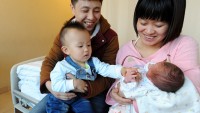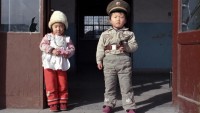China’s two Child Policy Gives Rise to Child Boom, Senior Health Official Claims
| Girish Shetti | | Mar 12, 2017 10:33 PM EDT |
(Photo : Getty Images. ) Wang Pei'an, deputy minister of the National Health and Family Planning Commission, said that China’s newly introduced two child policy has ushered a baby boom in China.
China's two child policy ushered a baby boom in China in 2016, giving a much needed hope to the world's most populous nation that it may able to resolve the aging population problem that is likely to affect the Chinese economy in long term.
A senior Chinese health official stated on Saturday that hospitals across China witnessed a sharp jump in live birth numbers last year. This is second time in less than one and half month that a senior health official has confirmed about on-going baby boom in the Asian country.
Like Us on Facebook
Wang Pei'an, deputy minister of the National Health and Family Planning Commission, stated that 18.46 million live births in hospital were recorded across the country in 2016, which is two million more than the average of the last five years. These encouraging numbers were accompanied by positive fertility rate numbers that rose to 1.7 in 2016 from the average of 1.5-1.6 recorded between 2000 and 2015.
"These figures show that the effect of the implementation of a comprehensive two-child policy is quite obvious and quite optimistic," Wang said a press conference on the sidelines of the Chinese annual parliament session.
He also added that his agency is coordinating with other ministries to create an environment across the country that is very conducive for child-bearing and child-rearing. Simultaneously, he shed light on some of the key hindering factors in implementing two child policies, including the issue of re-employment after childbirth, lack of childcare facilities for children and economic pressure.
Wang promised that the government would most certainly look to address the 're-employment issue' by working towards women's employment rights, extension of maternity leave and setting up a system of paternity leave.
China began to reverse the draconian one child policy in late 2013 by encouraging parents to rear another child, in case if they have given birth to another child. But the 'two child policy' was truly effectively implemented since the beginning of the last year.
The steady transition from one child to two child policy happened mostly due China's aging population problem, which positions the country in a great disadvantage when compared with other emerging economies as they are expected to have a greater share of youth population in the coming decade.
Several analysts' fear that if the aging problem is left unresolved then China may face great shortage in labour workforce, which can very well cripple the second largest economy.
Tagschina, China Two Child Policy, China One Child Policy, China Population Problem
©2015 Chinatopix All rights reserved. Do not reproduce without permission
EDITOR'S PICKS
-

Did the Trump administration just announce plans for a trade war with ‘hostile’ China and Russia?
-

US Senate passes Taiwan travel bill slammed by China
-

As Yan Sihong’s family grieves, here are other Chinese students who went missing abroad. Some have never been found
-

Beijing blasts Western critics who ‘smear China’ with the term sharp power
-

China Envoy Seeks to Defuse Tensions With U.S. as a Trade War Brews
-

Singapore's Deputy PM Provides Bitcoin Vote of Confidence Amid China's Blanket Bans
-

China warns investors over risks in overseas virtual currency trading
-

Chinese government most trustworthy: survey
-

Kashima Antlers On Course For Back-To-Back Titles
MOST POPULAR
LATEST NEWS
Zhou Yongkang: China's Former Security Chief Sentenced to Life in Prison

China's former Chief of the Ministry of Public Security, Zhou Yongkang, has been given a life sentence after he was found guilty of abusing his office, bribery and deliberately ... Full Article
TRENDING STORY

China Pork Prices Expected to Stabilize As The Supplies Recover

Elephone P9000 Smartphone is now on Sale on Amazon India

There's a Big Chance Cliffhangers Won't Still Be Resolved When Grey's Anatomy Season 13 Returns

Supreme Court Ruled on Samsung vs Apple Dispute for Patent Infringement

Microsoft Surface Pro 5 Rumors and Release Date: What is the Latest?












